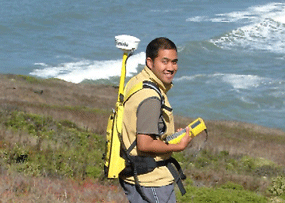 |
 | |
  | |
|
|
|
|
Golden Gate National Recreational Area
Nature & Science
|
|
|
|
|
|
 |
 |
| NPS photo | | Park intern mapping invasive species |
 |
As most of California and our nation become developed, urban national parks and their resource management issues become increasingly important. The San Francisco Bay region has notably rich biological diversity due to the variety of habitat and unique geology.
Over half of North American avian species and nearly one third of California's plant species are found in the park. 24 federally threatened and endangered species exist within lands that the Park Service manages, and a total of 33 threatened and endangered species exist within Golden Gate's legislative boundaries.
The Recreation Area is spread through a 60 mile swath of coastal lands, with inholdings by other agencies and private owners incorporated into the park’s legislative boundaries. Because of the multiple landowners, many Bay Area residents and park visitors think of our park in terms of isolated sites such as Muir Woods, Stinson Beach, the Marin Headlands, and the Presidio. The bigger picture is one of wildlife corridors, secret nature spots, and refuges for rarities. Traveling through the park connects you with windswept beaches, dramatic cliffs, coastal chaparral, low mountains, swaths of prairie, live oak woodlands, salt marshes, freshwater wetlands and creeks, and redwood forests. All you have to do is get out and explore!
|
|
Managers are working to stop habitat loss and preserve local biological diversity. Learn more about park restoration and monitoring projects at locations such as Crissy Field, Fort Baker, The Presidio, Mori Point, and Banducci!
|
|
Managers are working with the Inventory & Monitoring Program to track long term trends in the park's natural resources. Scientists are monitoring a suite of ecological indicators which will tell them about ecosystem health and changes.
|
Coyote Alert
Recently, coyotes have been observed frequenting roadsides and pullouts, and even approaching cars, in the Marin Headlands of the Golden Gate National Recreation Area. This behavior is consistent with coyotes that are being fed.
|
|
Climate Change“Earth’s climate is changing, with global temperature now rising at a rate unprecedented in the experience of modern human society.”
—Arctic Climate Impact Assessment, 2004
|
|
|
2008 GGNRA Endangered Species Big Year
It is a race against time to observe each of the 33 endangered and threatened species found within the Golden Gate National Recreation Area (GGNRA), while taking 33 discrete conservation recovery actions that will prevent these species from going extinct. It is a competitive event: the person who sees and helps the most species between January 1, 2008 and December 31, 2008, will win the Big Year.
|
|  |

|
 |
|
|
|
|
|
 |
|
Did You Know?
Nearly half of the serpentinite found in North America is located in California, making it a natural choice for the state rock.
|
|
|
|
Last Updated: September 12, 2008 at 11:51 EST |






